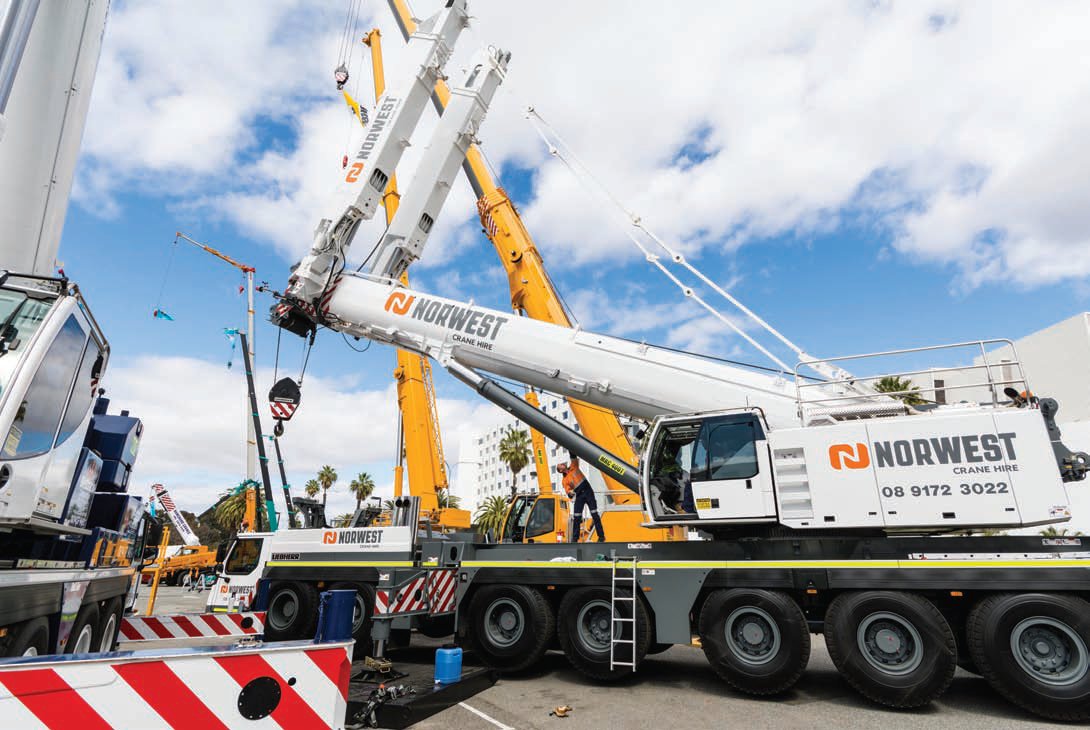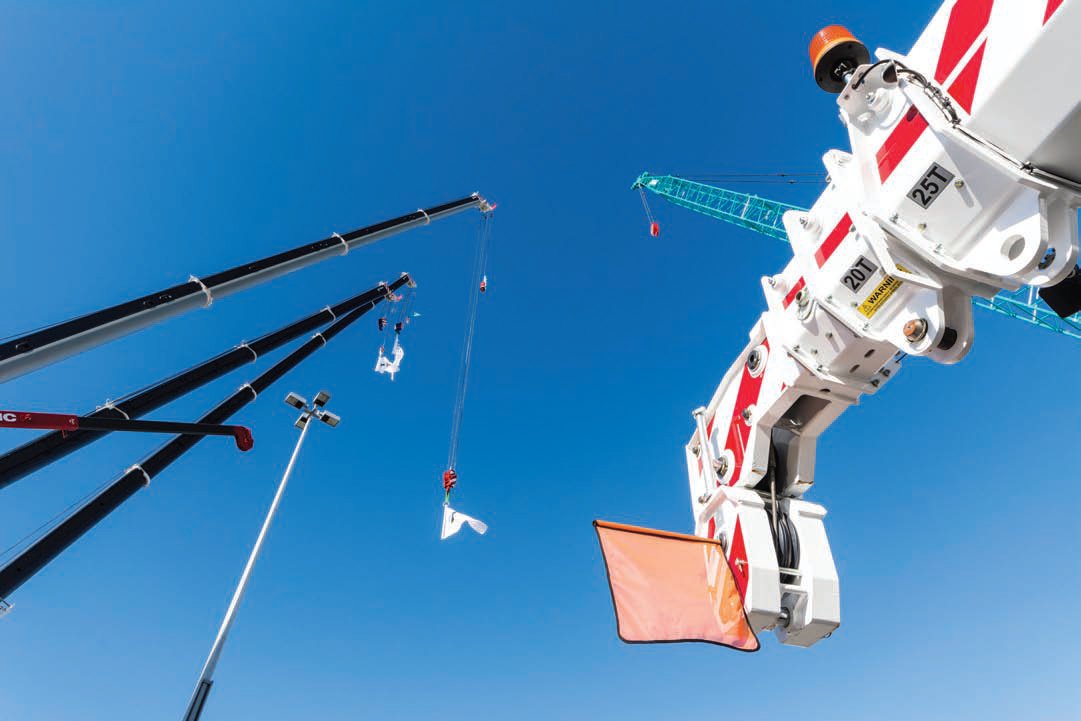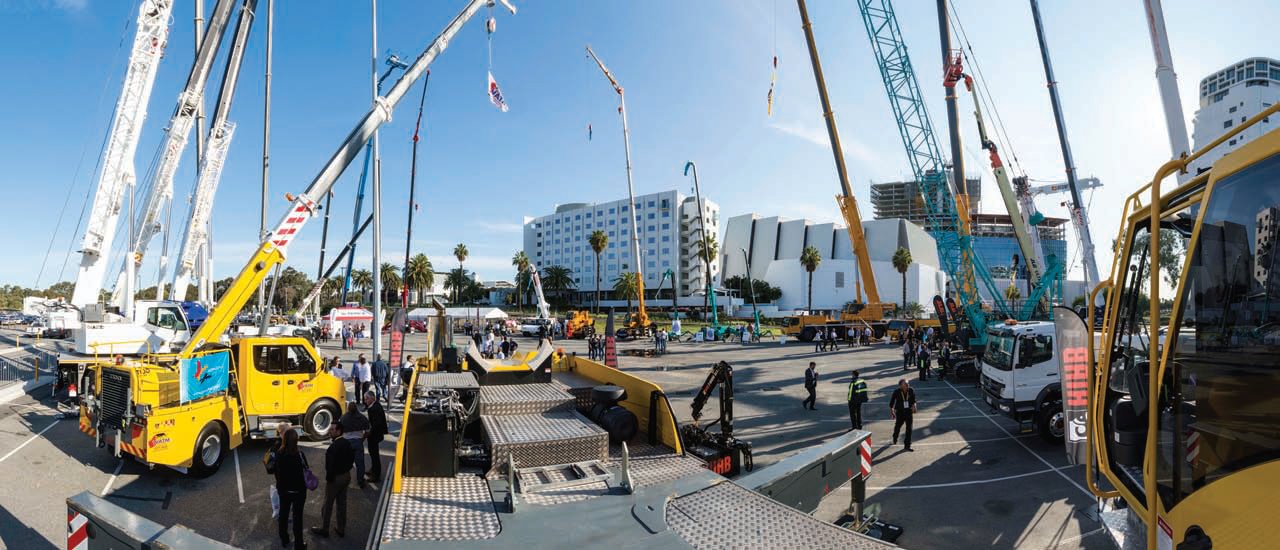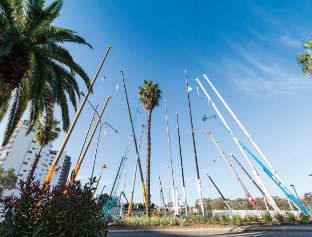Still the lucky country?
30 October 2015Arriving at the recent CICA Crane conference in Perth, Western Australia, Stuart Anderson expected a lot of long faces and sob stories. Instead, he found crane users and dealers fairly upbeat.
The downturn in China's economy and its severe impact on Australia's huge resources (minerals) industries during the past three years has been widely reported. One might expect this to damage confidence among crane owners and dealers at the CICA conference. But, to the contrary, the overall mood was surprisingly upbeat amongst most, if not all, delegates. Given the challenges of the resources industries and the fact that investment in the country's enormous LNG projects seems at least past it peak, the economic prospects for Australia are now much less positive.
Platinum Sponsor for the Perth Conference was Kobelco crane distributor Australian Crane & Machinery. For many years now ACM and Kobelco have been the Oceania crawler crane market leader and this year ACM displayed the latest 90t Kobelco model complete with full boom and jib.
ACM's iconic founder David Potter recently retired, handing over the reins to his eldest son Ben who has been personally responsible for the company's successful diversification into the manufacture of highly-specialized truck-mounted overhead wire maintenance vehicles with work heights to 50m. During his conference presentation Ben Potter also described ACM's highly successful used crane exporting activities, with over 200 units shipped to India alone. "We also just delivered the first 550t SL 6000G-Series crawler crane to BAE Systems Henderson shipyard near Freemantle, WA-only the fourth to leave to Kobelco factory," says Potter.
Despite a slightly reduced attendance the conference agenda was truly outstanding with particularly notable presentations on 'Metal fatigue' by Liebherr's chief engineer Hans-Dieter Willim and 'Mobile Crane Safety: Functions and Related Man machine Interfaces' by Terex's Klaus Meissner-not to mention the unmissable 'Manufacturers Panel' M.C.'d by past-CICA president John Gillespie. Unique in the crane world, this year's expanded and truly illustrious panel included Terex's Klaus Meisner, Tadano's Alexander Knecht, Manitowoc Cranes incoming president Larry Weyers, Link- Belt's Bill Stramer, Liebherr MD Christoph Kleiner and for the first time, Ryusuke Yanagido of Kobelco Cranes. The only criticism was that the session could easily have lasted twice as long.
The depth and severity of Australia's economic issues is only now receiving the media and public attention it demands. The recent coup d'état that saw the country 'elect' its fifth prime minister in five years afforded incumbent Malcolm Turnbull the opportunity to spell out the challenges faced by the 'Lucky Country'. "The big economic changes that we're living through here and around the world offer enormous challenges and enormous opportunities and we need a different style of leadership", he said soon after having usurped his former boss, Tony Abbott.
The fortunes of Australia's largest crane hirer, Boom Logistics, fairly reflect the economic impact on the nation's industry. For the fiscal year to June 30th, Boom reported a 24% decline in revenues from AU$268.1m to AU$203.3m with a 'statutory' EBIT loss of $33.2m and an EBIT trading loss of AU$6.3m. Last year Boom reduced its workforce by 19% (147 positions), made AU$20.3m in 'surplus' asset sales and reduced its equipment sub-contract volume by 25% (AU$4.6m). After a very challenging fiscal 2014, Boom's CEO Brendan Mitchell acknowledges that conditions worsened beyond the company's expectations. Commodity prices, particularly iron ore, fell rapidly; overall crane market activity contracted; several construction projects were cancelled; while project activity in the infrastructure sector were 'subdued'. Mitchell says that major customers are "expecting significant cost reductions" and acknowledges that the market is "showing no significant signs of rebounding in the medium term". This has seen Boom's fleet downsized from over 400 cranes in 2013 to over 250 today. Two years ago the firm operated from 40 depots across Australia- this is down to 20 locations today. In 2013 the company employed over 1,000 employees. Now it's down to 550.
In March Boom completed a 10-month contract at the Bald Hills Wind Farm in Tarwin Lower, South Gippsland, Victoria. This centered around Boom's largest crane, the 750t Liebherr LR 1750 lattice crawler. Originally acquired new in late 2009, the crane was subsequently upgraded with a new SDB derrick mast affording a variable derrick ballast radius from 13 to 20m. On this job the crane erected 52 2.05Mw wind turbines with hub heights of 80m and rotor diameters of 92.5m. However since that project was wound up, work for Boom's Heavy Lift Division has been disappointingly slow.
Australia's economic picture is indeed dire. Quarterly GDP growth for the June 2015 period was an anemic 0.2% with 'recession' now being on the lips of several economic forecasters. Australia has the fastest growing debt in the developed world and a shrinking federal budget. However, perhaps most challenging remains the fact that for most Australians the penny really still hasn't dropped. It's a country that prides itself on having 'dodged' the global financial crisis and that is populated by an entire generation that has only ever known economic growth and rising prosperity. Recessions and economic downturns are something for the rest of the world-not Australia.
The resources boom was a phenomenon that few saw ending. According to the Australian Bureau of Statistics, the nation's exports of crude materials grew 705% from AU$1.2bn at the beginning of 2001 to AU$10.4bn by the end of 2013. The World Bank estimates that gross national income per capita grew 224% from US$19,960 in 2002 to US$65,410 in 2014. Fuelling the fire, starting in 2003-4 the Australian Federal Government doled out seven consecutive years of personal income tax cuts.
Similar to other countries that failed to 'repair the roof while the sun shined', the Australian Government saved just AU$1 out of every AU$19 received in additional revenues during the commodity boom. Such has been the steepness in the decline in commodity prices that several mine sites have been temporarily closed while the routine mining equipment maintenance contracts upon which crane hirers have long depended have been cancelled or curtailed.
It's been almost four years since Western Australia's largest crane hirer, Freo Group, was acquired by Canada's Sterling Crane (part of Marmon Crane Services-a Berkshire Hathaway company). In the wake of that acquisition, Freo's crane purchasing policies were radically changed with all purchases consolidated to Canada. In addition, the company's all terrain crane choices have substantially moved away from Liebherr and in favour of Tadano-Faun, for which Sterling has long been the Western Canada distributor. At the conference Tadano mounted an impressive display of its RT crane line topped by the 145t GR-1450- EX2, several of which are owned by both Freo and Sterling. While Freo too has reduced its crane fleet, Berkshire Hathaway corporate information release policy is very restrictive.
Albert Smith is one of the most experienced and committed crane owners in Oceania. The company that is now his core operation- Universal Cranes-was founded in 1993 and has become one of Australia's largest privately-owned crane hirer companies. Albert is one of the more forthright and knowledgeable figures in the Australian crane industry and was recently elected as president of the Crane Industry Council of Queensland as well as being a CICA main board director. For some years now, Universal has been a major player in Queensland where it operates a complete network of branches. However last year Universal broadened its base with the opening of a branch in Melbourne, Victoria and of Universal Cranes South Australia.
"With Universal we cover all day-to-day dry hire and mannedand- operated crane services with everything from mini crawler cranes, Tom Thumbs (mini RTs), all terrains, rough terrains, telehandlers, truck cranes, crawler cranes and tower cranes," says Smith. "The largest crane in our fleet is a 600t Terex- Demag CC 2800-1 which we bought from Mammoet which has been a good crane for us."
But New Zealander Albert has never been shy to try something new. His Australian fleet includes the full spectrum of brands including Sany and Fushun lattice crawler cranes and the new Tidd (TRT) pick-and-carry crane. He's a tough negotiator and one of the more knowledgeable operators when it comes to going crane rates and prices, regulations and standards-not much gets past Albert.
Smith takes a very pragmatic view of his business and the crane market in general: "Right now we're in the export business-with the decline in the value of the Aussie dollar we're shipping idle cranes to India and the Middle East. We're active throughout the South Pacific with cranes in Guam, PNG (Papua New Guinea) where we have five or six cranes and New Caledonia where we have around ten cranes."
Smith concedes that market conditions are currently better in New Zealand than they are in Australia. He has significant interests in Hamilton-based Waikato Cranes and its sister company Auckland Cranes which runs a combined fleet of some 40 mobile and crawler cranes topped by Grove GMK 6300L and Terex-Demag AC 350 all terrains. "Of course we also have a close relationship with Christchurch-based Smith Cranes & Construction, run by my brother Tim, which recently took delivery of a new 60t Liebherr LTM 1060-3.1 and also has a Grove GMK 6300L."
September saw the delivery to Tutt Bryant Heavy Lift & Shift of the region's first Manitowoc MLC 650 with VPC (Variable Position Counterweight) and rated up to 700t with VPC "Max". It joins one of Australia's largest fleets of heavy crawler cranes that includes four 400t Manitowoc M 16000s, three Sany SCC 4000Es, a 550t Kobelco SL 6000, a 600t Terex-Demag CC 2800-1 and the 1,600t Terex- Demag CC 8800-1 that arrived in August 2012. Operations manager Malcolm Smith is in no doubt as to the cost-savings attributes of the Manitowoc VPC system: "We ordered the crane with 86m of main boom and the savings on trucking the carbody counterweight alone are a home run. Time and money spent on ground preparation will also be key competitive advantages.
"Training of our operators, mechanics and team has already been started by Western Australian Manitowoc distributor WATM. We've already got the MLC 650 booked for 20 weeks on the Wheatstone LNG project. Our CC 8800-1 has also been a great success with only two-months idle in going-on four years service. Work has also been good in Victoria where we have 26 cranes on an Esso gas plant for CBI."
The dramatic weakening of the Australian dollar, especially against the US dollar, has had a huge impact on the local crane market. Import costs for new cranes have skyrocketed-with US-sourced cranes the hardest hit. Link-Belt distributors the Baden- Davis Crane Connection continues to make headway despite the economic headwinds. "It's very tough given the general condition of the economy and the exchange rate impact," says sales director, Anthony Davis.
"Nevertheless we recently scored a notable success delivering two 135t RTC-80150 Series II RTs to Lee Cranes up in Queensland. We've had a good deal of success with the three-axle 100-135t Link-Belt RTs. As soon as people have them, they love them. The telecrawlers have also found a big fan In Wagstaff Piling which recently took delivery of another 100t TCC 1100, their fifth Link-Belt telecrawler."
A somewhat unlikely success story in Australia has been Link-Belt's HTC 86100 tele truck crane. Rated 85t in Australia the distributor boldly introduced the crane back in 2012 as an alternative to the 50-55t Japanese (and later Chinese) truck cranes that dominated the taxi crane market for decades. Notwithstanding the fact that the Link-Belt name and indeed virtually all US-made truck cranes had been absent from the Australian market for the better part of a generation, converting the market to an 85-tonner was a pretty strong call. Nevertheless, step-by-step, crane by crane, the message has got through.
An early buyer was Launceston, Tasmania-based Cranes Combined. At the Conference, Cranes Combined managing director Chris Kolodziej told Cranes Today: "The HTC 86100 has been a really, really good crane for us. It's been extremely reliable, has a very good load chart and is freely roadable throughout 98% of our state without a dolly-albeit without with reduced counterweight and without jib but nevertheless ready to work with hookblocks and spare wheel and tyre. Of course we can also road it widely under Class 3 or 4 regulations with heavy counterweight and jib.
"We now operate a fleet of 27 mobile cranes following the acquisition of a serious local competitor last year. We've steadily grown our fleet buying a 100t GMK 4100L in 2011 before we bought the Link-Belt in 2013. From dayone the Link-Belt has behaved flawlessly-it went straight from the wharf to lift a very valuable old locomotive 10 miles (16km). Frankly during these three years we haven't had to check-up on Baden-Davis and Link-Belt's product support, there really haven't been any parts and service issues to speak of."
Another happy owner of the HTC 86100 is Melbourne-based Williamstown Crane Hire, whose Tom Smith told us: "We just bought our third one-but this time we chose the HTT 86100 with allwheel steer. The crane has great highway performance, it simply rockets along. We don't need any special permits and is much better value than 55t all terrain cranes, even with the Greenback being so strong."
While also squirming at the impact on its prices of the US dollar, Grove continues to enjoy outstanding success with its sixaxle 300-400t all terrain crane series. John Stewart, recentlyappointed GM and VP of Manitowoc Australia after some 20 years' service for the company in various senior roles in Australia and South East Asia, is happy to be back 'down under'.
"The 6300L has been amazingly popular in Oceania," said Stewart, standing next to the 'conference' crane ready for delivery to FG Cranes of Perth. "I guess this with be number 16 or 17 and we've also just delivered the second and third GMK 6400-to Borgers and 'The Men from Marrs'-both in New South Wales, with South Australia's Flerieu having taken the first. I'm also looking forward to the delivery of the first of the new 250t GMK 5250Ls which is arriving here in Australia in November."
But there's no mistaking Stewart's excitement at the sales prospects for the new 300t and 650/700t Manitowoc VPCs: "When you've been in the industry for a few decades you know when a real game changer comes along and this is it," says Stewart. "It's all about return on investment-cranes are an investment tool-though occasionally people seem to forget that. The transport and ground prep cost savings alone make an argument that's very difficult to ignore."
While the Euro hasn't strengthened against the Australian dollar to the same extent as with the US dollar, European crane prices have also increased significantly in Australia. Even so, Anthony Heeks, managing director at Sennebogen distributor PACE Cranes, reports that his company is having its best year in 28 years since his father Paul started the business:
"People are really starting to understand the benefits of our tele-boom crawler cranes. We're now closing in on some 40 Sennebogens here in Australia. What's more, and quite remarkably, we just sold a 55t Sennebogen dragline-to Rangitata on the South Island of Australia. WGC Cranes based in Wollongong, New South Wales is about to take delivery of our first 51t 853E telecrawler to join the two 40t 643Rs they purchased over the past 12-18 months.
"Also Prestons-the nationwide mini-crawler crane hirer with over 50 Maedas sold by us-now has five 15t Sennebogen 613Rs and two 40t 643Rs. It's exactly the scenario we envisioned when we took on the Sennebogen franchise six years ago-building on our large population of Maeda minis into progressively larger tele-boom crawler cranes."
Meanwhile all terrain crane market leader Liebherr recognises that demand has weakened and continues to dip.
"This year has been quite reasonable thanks to some multiunit deliveries to Rio Tinto and Chevron. However, next year will be significantly more difficult," says Liebherr Australia GM Andrew Esquilant.
However, as difficult as the tightening market may be for importers, their plight dulls compared to the difficulties facing Oceania's manufacturers of articulated pick-and-carry cranes. From a peak four years ago of around 350 units, demand last year scratched past 100 and this year will likely be down by another 30% or more.
Terex-Franna continues to dominate the market with its 25t Mac 25 and updated 23t AT-20-3. Prices for 'young' used Frannas fell through the floor last year and it seems likely that it will be minimum of 2-3 years before domestic new crane demand recovers significantly.
It's even more challenging for New Zealand's TRT. Entering a market with its 25t capacity TIDD PC 25 to compete with the iconic Franna four years ago was tough enough. But given current market conditions, they have a tough road to hoe indeed.




